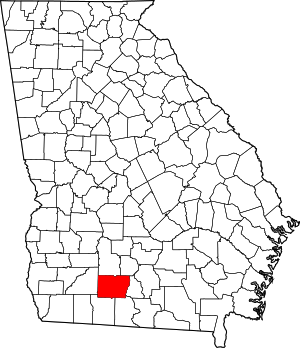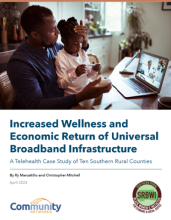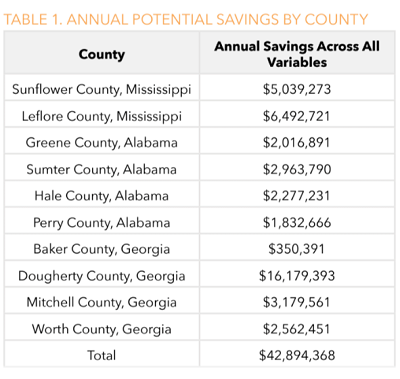
Fast, affordable Internet access for all.

Windstream Communications and local nonprofit electrical cooperative Colquitt Electric Membership Corp are partnering on a $32.5 million fiber deployment that will bring fiber optic broadband to 17,000 homes and businesses in Colquitt County, Georgia.
Once completed sometime next year, the partnership should help deliver last-mile fiber access to roughly 70% of Colquitt County residents, many of which either have no current broadband access, or have long been stuck on sluggish, expensive, and dated digital subscriber line (DSL).
Windstream will maintain ownership of the finished network and provide residential service under its Kinetic brand, while Colquitt EMC will utilize the network to help maintain and support the company’s existing electrical grid.
Kinetic will use $21.4 million in American Rescue Plan Act (ARPA) grants to fund the network build, while providing $11.1 million of its own funds to cover any cost overruns. The company says it has already laid 180 miles of cable of an expected 440 miles total county wide.

“Colquitt EMC has been an instrumental part in the delivery of fiber in its service area,” Kinetic Georgia operations President Michael Foor said in a prepared statement. “We are grateful for its willingness to support these efforts.”
As ILSR has long noted, PPPs can be a decidedly mixed bag. They can be good for municipalities unable or unwilling to handle the logistics or cost of a major deployment alone. At the same time, locals don’t have much or any control over the trajectory of the finished network, including pricing that can quickly creep out of the range of affordability.

This week on the podcast, Christopher speaks with Keith Quarles, President and CFO of A2D, a fiber-based, open access competitive local exchange carrier (CLEC). A2D stands for ‘Analog to Digital,’ and as Keith explains, represents the infrastructure transition from analog to digital communications.
Chris and Keith discuss A2D’s business model, which focuses on filling in the gaps – serving communities where connectivity is unaffordable or the incumbent has chosen not to upgrade its infrastructure. Keith explains how many gaps still exist, even after the influx of federal funding for broadband. A2D takes a creative approach to building out fiber backbones in these pockets, which involves connecting existing ecosystems like municipalities, school systems, and electric membership corporations (Georgia’s equivalent of electric cooperatives). Keith’s background in real-estate development and training in civil engineering, along with the backgrounds of his three business partners who are also engineers by trade, informs A2D’s strategy and willingness to "just figure things out."
This show is 19 minutes long and can be played on this page or via Apple Podcasts or the tool of your choice using this feed.
Transcript below.
We want your feedback and suggestions for the show-please e-mail us or leave a comment below.
Listen to other episodes here or view all episodes in our index. See other podcasts from the Institute for Local Self-Reliance here.
Thanks to Arne Huseby for the music. The song is Warm Duck Shuffle and is licensed under a Creative Commons Attribution (3.0) license.

In a new report, published in partnership with the Southern Rural Black Women’s Initiative (SRBWI), the Institute for Local Self-Reliance (ILSR) Community Broadband Networks Initiative examines the link between high-speed Internet infrastructure, access to healthcare, and the economic implications involved.
The report –“Increased Wellness and Economic Return of Universal Broadband Infrastructure: A Telehealth Case Study of Ten Southern Rural Counties” has particular relevance for those living in rural broadband deserts as it details how universal, affordable, broadband infrastructure would return $43 million per year using telehealth across 10 counties in the Black Belt of Alabama, Georgia, and Mississippi. Read Increased Wellness and Economic Return of Universal Broadband Infrastructure: A Telehealth Case Study of Ten Southern Rural Counties [pdf].
It explains how robust broadband infrastructure could pay for itself in short order and open up untold access to healthcare, educational opportunities, economic development, community engagement, and other benefits along the way. This issue is particularly relevant today, because the BEAD program represents a once-in-a-generation investment in broadband infrastructure, larger than any other federal grant program many times over. While it will solve the issue of access to infrastructure for most rural households, we have significant concerns about affordability - BEAD will lead to new connections, but states have wide latitude as to which ISPs get those funds to build new connections. The national monopolies have a long history of charging more to exactly the communities that can’t pay as much, leaving many households out. The report argues that electric cooperatives offer better and more locally accountable paths to universal, affordable service.
Drawing on academic scholarship and existing telehealth programs at hospitals around the country, the report focuses on an assortment of chronic health ailments plaguing those counties, such as diabetes, chronic respiratory disease (including asthma, chronic obstructive pulmonary disease, emphysema, heart disease, heart failure, cancer, obesity, and mental health and then demonstrates the benefits that could come from effective telehealth interventions for each
In partnership with the Southern Rural Black Women’s Initiative (SRBWI), today ILSR is releasing a new report that examines the link between high-speed Internet infrastructure, access to healthcare, and the economic implications involved.
The report – “Increased Wellness and Economic Return of Universal Broadband Infrastructure: A Telehealth Case Study of Ten Southern Rural Counties” – has particular relevance for those living in rural broadband deserts as it details how universal, affordable, broadband infrastructure would return $43 million per year using telehealth across 10 counties in the Black Belt of Alabama, Georgia, and Mississippi.
At a virtual press briefing today, SRBWI leaders and organizers were joined by Dr. Sandra B. Reed of Emory Healthcare; as well as ILSR Senior Researcher and the report’s lead author, Ry Marcattilio, to explain how robust broadband infrastructure could pay for itself in short order and open up untold access to healthcare, educational opportunities, economic development, community engagement, and other benefits along the way.

“It’s easy to miss the connection, but hard to overlook what’s at stake as rural hospitals close and the cost of transportation to get to far-off healthcare facilities presents a real barrier. This is about access to healthcare and Black women being denied the opportunity to take advantage of telehealth. The broadband infrastructure that’s needed for that just isn’t there,” said Shirley Sherrod, SRBWI State Lead for Georgia and Director of the Southwest Georgia Project in Albany Georgia.
Broadband … to Access Longer, Healthier Lives
Kicking off the new year, Georgia Gov. Brian Kemp’s office announced $234 million of the state’s Capital Projects Fund (CPF) will be used to deploy new high-speed Internet infrastructure in the Peach State, courtesy of the American Rescue Plan Act.
The lion’s share of those federal funds, being administered by the state’s broadband office, will be gobbled up by the four national telecom giants operating in the state. The rest of the grant money will be shared by a half dozen electric cooperatives for smaller projects.
In total, the grants were awarded to 12 different applicants to fund 29 different projects across 28 counties.
“When combined with significant capital matches from the awardees, almost $455 million will be invested to serve over 76,000 locations in communities with some of the greatest need for high-speed Internet access,” the Governor’s office said in the Jan. 4 press announcement.
The Big Telecom winners were Comcast, netting almost $67 million for eight projects that looks to extend broadband access to nearly 28,000 locations; $39.3 million for five Spectrum projects that plan to pass nearly 19,000 locations; Windstream raking in $34.8 million for four projects to make high-speed Internet service available to 4,500 locations, and MediaCom hauling in $27.9 million for three projects to reach 8,200 addresses.
The electric cooperative grant awards were:
The U.S. Treasury Department announced another six states have been approved to receive nearly $1 billion in Capital Projects Funds from the American Rescue Plan to bring new broadband infrastructure to more than 180,000 homes and businesses.
The latest tranche of CPF funds is heading to Florida, Georgia, Iowa, Minnesota, Missouri, and Utah, bringing the total number of states to have been approved for their share of the $10 billion fund to 22 states.
Previous awards were announced in June, July, August, early October and late October. According to a Treasury Department press release, the remaining funds for additional states and Tribal territories will be released on a rolling basis.
U.S. Treasury Deputy Secretary Wally Adeyemo said the announcement further underscored the Biden-Harris administration’s commitment to invest in the expansion of reliable, affordable broadband infrastructure as the Covid pandemic “exposed the stark inequity in access to affordable and reliable high-speed Internet in communities across the country.”
This funding will lay the foundation for the Biden-Harris Administration’s historic investments to increase access to high-speed Internet and reduce Internet bills for American households and businesses.
Florida
The Sunshine State is set to receive $248 million to fund new broadband infrastructure that will connect an estimated 48,400 households and businesses, or about 10 percent of locations in Florida that do not have access to high-speed Internet. That amount accounts for 68 percent of the CPF funds Florida will receive as plans for how the state will spend the remainder of funds is still under Treasury review.
As voters went to the polls yesterday, broadband-focused initiatives and candidates could be found up and down the ballot all across the country.
Alabama
Alabama voters cast their ballots to decide on a state Constitutional amendment known as the Broadband Internet Infrastructure Funding Amendment. The measure sought to amend the state's constitution "to allow local governments to use funding provided for broadband internet infrastructure under the American Rescue Plan Act (ARPA) and award such funds to public or private entities."
That measure passed, garnering a “Yes” vote from nearly 80 percent of Alabama voters. With 73 percent of the vote counted late last night, 922,145 “Yes” votes had been tallied with 251,441 “No” votes.
Also in Alabama, Democratic U.S. Rep. Terri Sewell won her re-election bid to represent Alabama’s 7th congressional district. Sewell, whose district covers a large swath of the Alabama Black Belt, “spent much of her past two years in office bringing American Rescue Plan Act funds to rural Alabama, dedicated to healthcare, broadband access and infrastructure building,” as noted by The Montgomery Advertiser.
Colorado
The Centennial State is not listed as one of 17 states in the nation with preemption laws that erect barriers to municipal broadband because nearly every community that had a vote has passed it to nullify it. But more communities had to go through that unnecessary process yesterday due to the law known as SB-152 that bans local governments in the state from establishing municipal broadband service absent a referendum.
Known for decades as the "Sweet Onion Capital of the World," tourists are still drawn to the rural farmlands of Toombs County in east central Georgia for the annual Vidalia Onion Festival.
But in early November 2021, officials from the member-owned electric cooperative Altamaha Electric Membership Corporation (EMC), flanked by an assortment of state and local officials, gathered at the sprawling L.G. Herndon Farms to announce the cultivation of a new venture. Through its newly created subsidiary Altamaha Fiber, the 86-year-old cooperative recently started construction of a fiber-to-the-home network to serve its 14,000 members who live in Toombs County and in the six neighboring counties (Emanuel, Johnson, Laurens, Montgomery, Tattnall, and Treutlen).
A 5,000-acre spread where they grow Vidalia onions, greens, soybeans, and corn (with over 1,600 cattle and a trucking company on the property), L.G. Herndon Farms was chosen as the site to make the announcement because the farm also happened to be the first business test customer for Altamaha Fiber.
Fiber-to-this-farm will allow for precision agriculture. And, as reported by The Advance, Phil Proctor, the engineer overseeing network construction, noted an added benefit, especially in an area that prizes college football in the ACC: “The lines coming into this building would allow owner Bo Herndon to live stream the Georgia Tech vs. Virginia Tech football game in vivid 4k resolution.”
Beyond the Herndon farm, Georgia Public Service Commissioner Jason Shaw spoke of the far ranging benefits of broadband for the region:
Fiber-to-the-home service is on its way to three counties in Southeast Georgia. In July, the Midway-based Coastal Electric Cooperative and Darien Communications – a family owned telephone, cable TV, and Internet Service Provider – announced they were teaming up to build a $40 million fiber network. Once the initial network is up and running, 16,000 homes and businesses in the counties of Bryan, Liberty, and Long will have access to high-speed Internet service.
The partnership has given birth to a new co-op entity with Coastal Electric known as Coastal Fiber Inc., which will lease the infrastructure and begin offering retail broadband service as early as January 2022. Construction began this summer with phase one of the project slated to be rolled out over the next four years.
The new partnership will first target 9,800 homes in Bryan County, 6,200 in Liberty County, and 500 in Long County.
Phase 1 Focuses on Underserved County Residents
“The first phase goal is for customers in Liberty County to begin seeing availability in January 2022. The system will be built out in phases from that point with the total buildout by 2030. The service to Bryan and Long counties will be as we build out in phases. No dates for Bryan and Long have been determined yet,” Coastal Electric Communication Coordinator Bethany Akridge told the Savannah Morning News.
“The service in Bryan County, for example, depends on where you live. There is broadband available in the more populated areas because it is more profitable for companies,” Akridge said. “The reason the cooperative is involved is because there is a need, so we are stepping in to fill that need where those areas are not served or underserved.
There are more than 600 wireline municipal broadband networks operating across the United States today. And while the ongoing discussion about our information infrastructure by Congress has placed a renewed emphasis on publicly owned endeavors to improving Internet access, the reality is that cities around the country have been successfully demonstrating the wide variety of successful approaches for decades.
In this report, published by the Benton Institute for Broadband and Society, ILSR's Sean Gonsalves, Christopher Mitchell, and Jericho Casper profile how six community networks in a diverse range of places stepped up to meet the needs of their communities, bringing faster, more reliable, and more affordable service.
It covers:
The projects above, the report shows, run the gamut from municipally owned and operated fiber networks, to cable system upgrades, to last-mile open access networks, to public-private partnerships.
From Benton:
Communities seeking to create a more competitive broadband market and/or target low-income neighborhoods with high-quality, modestly priced service are increasingly building their own networks, whether in partnership with ISPs or on their own. Local governments considering this option have to do their homework to find appropriate consultants, vendors, business models, and more.
But as the communities profiled here demonstrate, there are many models and opportunities to improve Internet access.